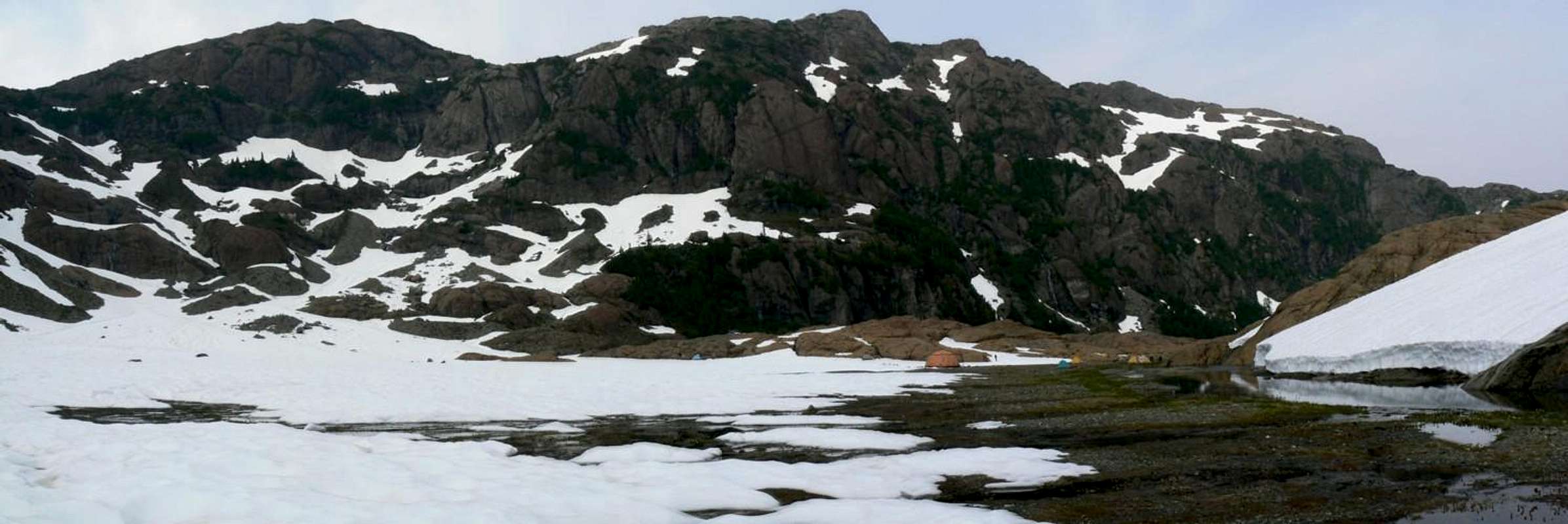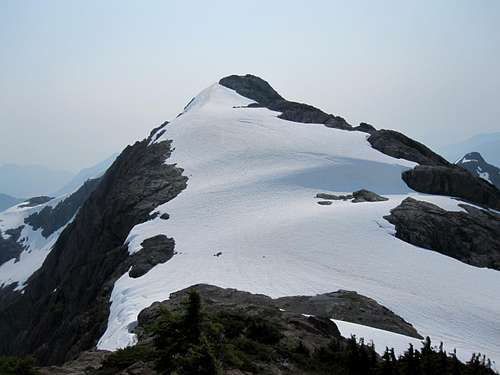-
 6339 Hits
6339 Hits
-
 76.66% Score
76.66% Score
-
 7 Votes
7 Votes
|
|
Mountain/Rock |
|---|---|
|
|
49.90900°N / 126.462°W |
|
|
Scrambling |
|
|
Spring, Summer, Fall |
|
|
5167 ft / 1575 m |
|
|
Overview
Tlupana Ridge is the unofficial name for the long serrated ridge that forms the eastern boundary of the Alava Bate Sanctuary, a little known and even less visited alpine paradise in west central Vancouver Island, British Columbia. The ridge also forms the eastern wall of the Conuma River canyon up which visitors travel when heading for the breathtakingly lovely Shangri La basin area of the Sanctuary.
The high point of the ridge, known to some as “Tarn Peak”, makes for a friendly Class 2 outing from Shangri La, either as an easy day or as a break from the technical rigours and exposure found on many of the other objectives in the area.
Not the least reason for enjoying a walk up to the ridge summit is the view. Probably the best view of the Sanctuary as a whole, particularly of neighbouring Mt Bate across the canyon, is to be enjoyed from there.
The ridge is usually climbed from Shangri La via the Thumb Peak col, although some have scrambled up from points lower down in the river canyon.
Getting There
Vancouver Island can be reached directly by air from Toronto, Vancouver, Seattle, Calgary, Edmonton and recently San Francisco to Victoria and by ferry from Port Angeles to Victoria on The Coho and on BC Ferries from Vancouver to Victoria or Nanaimo. Public transport on the Island is notoriously poor and anyone arriving by air would be advised to rent a car.Access to the main points of entry to the Sanctuary involves logging road travel but on main lines. A 2WD vehicle would normally be expected to suffice.
Tlupana Ridge is climbed almost exclusively from the Shangri La basin via the Conuma River approach and only this will be described here. Anyone wanting to approach from the Perry River via Peter Lake is referred to the parent area page.
From any point on southern Vancouver Island, drive north on the Island Highway 19 to Campbell River. From Campbell River take highway 28 west through Strathcona Provincial Park and onwards to Gold River. Just before entering the town of Gold River, watch for a right turn signed for Tahsis. It’s immediately after the tourist information office. Proceed 2 km on this road and across the bridge over the Gold River. Here the road splits. Right to Woss and left to Tahsis. Note this point on your odometer and turn left onto “Head Bay Road”. The pavement ends almost immediately, but this is good sealed or gravel road.
Drive about 27 km from the Gold River bridge and find Conuma Main on the right just after crossing the Conuma River. Drive this good main line about 11.5 km, passing the C15 access for Conuma Peak after 3.5 km and park at about N49 52.403 W126 24.954. The route to Shangri La Lake via the Conuma River approach starts here. Mt Bate towers above you to the northwest.
Approach
The approach described below involves heavy bush and difficult travel. These difficulties are in no small measure responsible for the few visitors that the Sanctuary has seen over the years.From the start point travel west and then follow the river north up the steep sided canyon. The route has been recently (July 2010) flagged. Beware of a dangerous river crossing at N49 52.753 W126 26.725. A ramp at N49 53.766 W126 27.450 is used to bypass a waterfall about half way up the canyon. Travel time to Shangri La 6-8 hours.
The Airborne Alternative
Over the years a number of visitors have accessed the area via helicopter. The local ecosystems in the Sanctuary are delicate and fragile and, in this case, an air assist might just be the least invasive way to reach and stay there. See the “Camping” section below.Summit Route
From the Shangri La basin walk north up snow or scree slopes to the Thumb Peak/Tlupana Ridge col at N49 54.574 W126 28.356 and about 1,450 metres elevation. Turn right (east).Continue east up lava slabs to the first high point at about N49 54.636 W126 28.109.
Continue southeast, dropping 50 metres of elevation down to a broad gravelly col and then up easy snow slopes to the cairned summit.
If desired continue southeast along the ridge for as long as you have available. A sub ridge to the north also leads off the first high point which is also worth exploring.
Descend the way you came up.
Route summary from Shangri La:
Distance to the ridge high point and return: ~ 4.5 km
Net elevation gain: ~ 400 metres
Total elevation gain: ~ 500 metres
Approximate time: ~ 2-3 hours return
As always a Garmin/Mapsource tracklog is available for the approach and route on Tlupana Ridge. Just ask for it via an email or PM.
Red Tape/Safety Considerations
Anywhere in the Alava Bate Sanctuary could not be more removed from the need to consider red tape. Almost no-one goes there and few outside the climbing fraternity know of its existence. With this caveat, therefore, comes the need to consider safety.Unless you’re supremely confident in your abilities to look after yourself come what may, I would consider a satellite phone mandatory for trips into this wild and remote area. Make sure that you have left a detailed trip plan with someone responsible. The appropriate SAR agency will respond in an emergency but it is up to you to have the mechanism in place that will initiate the call-out process if it becomes necessary. Know your exact coordinates at all times. Consider personal limited range radios for communication within your group.
Camping
Most visitors will camp on the extensive gravel flats at the outlet end of Shangri La Lake. These, and anywhere else in the Sanctuary, are areas which are delicate in the extreme. Fires are absolutely out of the question – there’s no wood anyway. Tread carefully amongst the acres of flowers. Try to keep your footprint as low as possible.Low to non-existent soil levels mean that disposal of human waste is a super critical issue. Above all other reasons (e.g. to avoid the difficult approach conditions) flying out waste and garbage is a strong argument in favour of keeping the area pristine by means of a helicopter assist and several parties have done just that.
Weather
Nearest point current conditions and forecast.East
West
Additional Information/Suggested Reading
As in the case of many objectives on Vancouver Island, Lindsay Elms, our local guru on all things obscure and hard-to-get-to, has written an excellent historical and geographical perspective of The Sanctuary on his Beyond Nootka website. Don’t fail to visit this site before your trip.Island Alpine – A Guide to The Mountains of Strathcona Park and Vancouver Island, Philip Stone, Wild Isle Publications, 2003, ISBN 0-9680766-5-3 and/or visit Island Alpine Climbing Guide
An excellent guide to the back roads of Vancouver Island is Backroad Mapbook. Volume III: Vancouver Island
Map Issues
The map for this trip is the government 1:50 000 topographical map sheet 92-E/16, “Gold River”. Advance copies can be ordered on-line at this link. Copies are usually readily available in good bookstores and outdoor stores throughout the Island.
Be aware that many features of the Sanctuary are mislabeled on the government map. Mt Alava is placed where the lower south satellite is located and Mt Bate is, in reality, located some 500 metres to the northeast of its map label.








